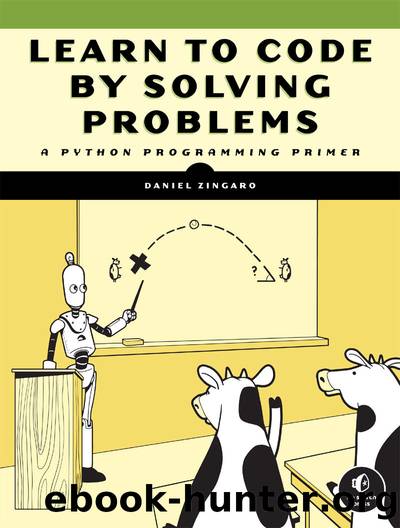Learn to Code by Solving Problems: A Python Programming Primer by Daniel Zingaro

Author:Daniel Zingaro
Language: eng
Format: mobi, epub
ISBN: 9781718501331
Publisher: No Starch Press, Inc.
Published: 2021-07-15T00:00:00+00:00
The Top Level
To begin our design, we focus on the main tasks that weâll need to solve.
Weâll certainly have to read the input, so thatâs our first task.
Now, assume that weâve read the input. What should we do to determine whether the boxes can be organized? One important thing to do is check each box on its own to make sure that its action figures have their heights in order. For example, suppose that we had the box [18, 20, 4]. This box, with heights out of order, means that we have no chance of organizing all of the boxes. We canât even organize this one!
So, thatâs our second task: determine whether each box, on its own, has its action figures in order. If any of these boxes has its action figures out of order, then we know that the boxes canât be organized. If all boxes are OK, then we have more to check.
If each box on its own is OK, the next question is whether we can organize all of the boxes. One important observation we can make here is that the only action figures we care about from now on are the ones at the left and right sides of each box. The action figures between these donât matter anymore.
Consider this example where we have three boxes:
[[9, 13, 14, 17, 25],
[32, 33, 34, 36],
[1, 6]]
The first box starts with an action figure of height 9 and ends with an action figure of height 25. Action figures placed to the left of this box must all have height 9 or less; for example, we can place the third box to the left of this box. Action figures placed to the right of this box must all have height 25 or more; for example, we can place the second box to the right of this box. The action figures of heights 13, 14, and 17 change nothing; they may as well not be there.
Thatâs our third task then: ignore all action figures except those on the ends of boxes.
Following that third task, weâll have a list that looks like this:
[[9, 25],
[32, 36],
[1, 6]]
Itâs a lot easier to tell whether we can organize these boxes if we first sort them, like this:
[[1, 6],
[9, 25],
[32, 36]]
Now itâs easy to see what the neighboring boxes of a box must be. (We used a similar approach when solving Village Neighborhood in Chapter 5.) So, our fourth task is to sort the boxes.
Our fifth and final task is to determine whether these sorted boxes are organized. They are organized if the heights of action figures are sorted from left to right. The action figures of heights 1, 6, 9, 25, 32, and 36 are appropriately sorted, so the previous boxes can be organized. But consider this example:
[[1, 6],
[9, 50],
[32, 36]]
These boxes canât be organized because of that huge action figure in the second box. That second box takes up heights 9 to 50; the third box canât go on the right of the second box because its heights are too small.
Download
Learn to Code by Solving Problems: A Python Programming Primer by Daniel Zingaro.epub
This site does not store any files on its server. We only index and link to content provided by other sites. Please contact the content providers to delete copyright contents if any and email us, we'll remove relevant links or contents immediately.
API Testing and Development with Postman by Dave Westerveld(4084)
Learning C# by Developing Games with Unity 2020 by Harrison Ferrone(3062)
Software Architecture for Busy Developers by Stéphane Eyskens(2845)
2021 Beginners Guide to Python Programming Language: A Crash Course to Mastering Python in One Hour by Elmer Gary & Elmer Gary(1916)
Machine Learning for Algorithmic Trading by Stefan Jansen(1674)
Hands-On ROS for Robotics Programming by Bernardo Ronquillo Japón(1604)
Delphi GUI Programming with FireMonkey by Andrea Magni(1493)
Game Development Projects with Unreal Engine by Hammad Fozi & Goncalo Marques & David Pereira & Devin Sherry(1450)
Cloud Native with Kubernetes by Alexander Raul(1408)
Datadog Cloud Monitoring Quick Start Guide by Thomas Kurian Theakanath(1374)
Software Architecture Patterns for Serverless Systems by John Gilbert(1368)
Practical Node-RED Programming by Taiji Hagino(1361)
Automate It with Zapier by Kelly Goss(1350)
Practical System Programming for Rust Developers by Prabhu Eshwarla(1339)
Delphi Programming Projects by William Duarte(1328)
Mastering React Test-Driven Development by Daniel Irvine(1321)
Advanced Algorithms and Data Structures by Marcello La Rocca(1291)
Developing Multi-Platform Apps with Visual Studio Code by Ovais Mehboob Ahmed Khan & Khusro Habib & Chris Dias(1286)
Ghidra Software Reverse Engineering for Beginners by A. P. David(1273)
